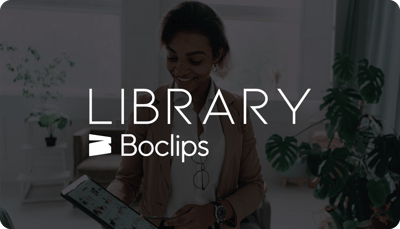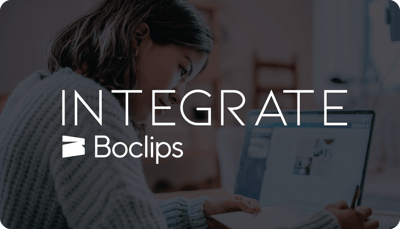At Boclips, we love to talk about the wonders of educational video. Students are better engaged with content (up to 24%), experience learning gains (up to 9% higher test scores), and have audiovisual access points to information they did not have before, all thanks to instructional videos. Classroom educators may wonder if educational video is so great, how can it be used to improve education in the classroom? It’s a great question. It’s one thing to understand the value of classroom video, but another to know how to use it effectively. With this in mind, here are 16 ways educators can use video in the classroom:
Download 6 digital learning strategies for classroom worksheets.
- Introduce New Topics. Introducing and framing a new subject or topic or theme of a unit can be daunting. A video clip can give students an overview of a subject that engages them with audiovisual access to the content. While educational videos cannot replace teacher instruction, short clips can support instruction in a way that text or a lecture cannot.
- Offer Diverse Viewpoints. A text can expose students to diverse voices, but the impact is much higher when students are able to actually hear those voices and see the people expressing their points of view. Educational video allows students to experience diverse viewpoints directly from the source.
- A Window to the World. If a picture is worth a thousand words, then a moving picture is worth a million. With classroom video, students can experience other cultures’ sights and sounds in a vivid and engaging way that text alone cannot match. Paired with text that provides historical and cultural context, a short video about another culture can spark students’ interest.
- Flip the Classroom. In a traditional classroom model, new ideas and concepts are introduced in the classroom, and then practice and consolidation of those ideas are done with homework. A flipped classroom uses short videos played at home to introduce content to students and then synthesis and practice take place in the classroom.
Boclips offers a world-class YouTube alternative for schools. Safely share curated, curriculum-aligned videos without distractions, ads, or misinformation. Sign up for free.
- Synthesis & Summary. To properly explain complex ideas and their connections, lessons will go through cycles of introduction, explanation, and synthesis. Educational videos can be excellent punctuations that can summarise new information and synthesize it so that learners grasp those complex ideas and the ways they’re connected.
- An Excellent Complement. With auditory and visual stimulation being the main way people store memories, videos can be an excellent way to maximize the amount of content that learners can effectively consume within a lesson. Complementing traditional educational methods like a lecture or a Socratic discussion with a relevant educational video can ensure students get the most out of a lesson.
- Maximal Personalisation. It’s well-known to any educator that everyone learns differently and every learner’s set of skills will develop at different paces. Using a classroom video in conjunction with a text will offer access points for students whose visual processing is more advanced than their linguistic comprehension or learners with limited abilities to focus.
- Classroom Without Walls. Students get sick, families travel, life happens and school can be missed. With educational videos, however, a lesson can be accessed anywhere. Recording the classroom lesson or experiment and posting it with a worksheet can help any otherwise absent student stay on track no matter what life throws at them.
- Keep It Current. Connecting lessons to the world outside the classroom can spark learners’ interest and equip students with relevant context. A lesson on soil ecology could be enhanced by a video news piece on the effects of factory farming. The story of the Triangle factory fire can become more relevant when supported by a video about current safety measures.
- Flexible Assessments. Traditional educational modes favour essays, speeches, or a slide deck as methods of assessment in the classroom. Using a digital video platform, students can create short video presentations that will engage the rest of the class and make for easy re-viewing later when the educator needs to grade it.
- Skills For Today’s World. Because it’s a highly effective way to communicate, digital video is here to stay. This is a learning opportunity for classrooms everywhere to sharpen critical thinking skills and media literacy so that learners are well-equipped to navigate a rapidly advancing ecosystem of fake news, deep fakes, and misinformation. Using educational videos to support lessons on information provenance can give learners the edge they need.
- Break It Down. Complex subjects become more accessible for learners when a more complicated idea is broken down into smaller pieces or steps. For example, supplementing a maths lesson about finding the volume of a prism with short video clips can work wonders. Each clip could show a step of solving the formula with the educator pausing to allow students to try it on their own before continuing.
- Defy Logistical Limits. Many classrooms lack the resources needed to perform scientific experiments and others lack access to quality museums. Educational videos side-step these logistical limits by bringing them to the students. A classroom video of a peroxide-and-baking-soda volcano model obviates the need for supplies and a video tour of a car factory brings the field trip into the classroom.
- Morning Warm-Up. When students are starting their morning at school, play a video summarising recent current events to keep learners abreast of what’s happening in their world. Alternatively, if there’s a lesson later in the day that could use some introduction, play a relevant video during the morning to familiarise learners before they dive in.
- Bring Words to Life. Reading books and acting out plays can spark student imaginations. Digital video can spark discussion. Using clips of theatre renditions and film adaptations of the text learners are reading, learners can be exposed to a wide range of interpretations and grasp stories as versatile and fluid objects. Use a series of clips showing different versions of a story to start a discussion during a lesson that can expand students’ minds.
- Video as Reward. Students want digital video content in the classroom, so why not make video content a reward for working through a lesson? Maintaining a cycle of effort and recognition of that effort can build great momentum in the classroom and cement a positive educational experience. Age- and school-appropriate videos can be a great way to offer levity and much-needed brain breaks.
Sign up for Boclips Classroom for free to share over 2.2M curriculum-aligned, educational videos with students. Learn more about Boclips Classroom here.
- #Classroom
- #Video in Digital Learning
- #Educational Videos
- #Tips for Using Video
- #Video Content Partners
- #Boclips for Publishers
- #Issues in Education
- #Educational Videos by Subject Area
- #News and Announcements
- #Events & Holidays
- #Video and Teaching Tools
- #Teaching Methodologies
- #Education Videos
- #Video and Digital Literacy
- #Short Educational Videos
- #Instructional Design
- #Multimodal Learning
- #Video and Student Safety
- #Accessibility in Education
-3.png?width=390&height=223&name=Untitled%20design%20(2)-3.png)


.png?width=1152&height=660&name=Copy%20of%20Untitled%20Design%20(1).png)



